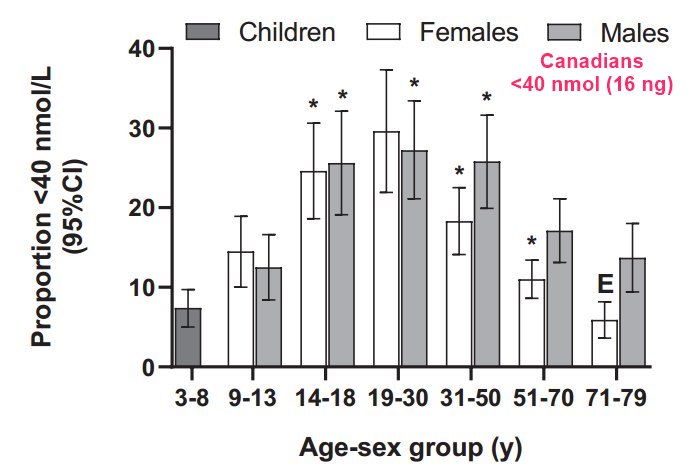1 in 5 Canadians have inadequate Vitamin D (less than 16 ng), far more if dark skinned – Canada
Vitamin D Status of People 3 to 79 Years of Age from the Canadian Health Measures Survey 2012-2019
J Nutr. 2023 Apr;153(4):1150-1161. doi: 10.1016/j.tjnut.2023.02.026
Hope A Weiler 1, Kurtis Sarafin 2, Chantal Martineau 3, Janice L Daoust 3, Krista Esslinger 4, Linda S Greene-Finestone 5, Lidia Loukine 6, Veronique Dorais 6

Background: Vitamin D is recognized in bone health and the prevention of rickets and osteomalacia.
Objective: This study aimed to assess vitamin D status of people in Canada and to identify factors associated with vitamin D inadequacy and deficiency.
Methods: Serum 25-hydroxyvitamin D (25(OH)D) from the Canadian Health Measures Survey (cycles 3-6, n = 21,770, 3-79 y) were evaluated for geometric means and proportions <40 (inadequate) and <30 (risk of deficiency) nmol/L. Factors associated with inadequacy or deficiency were tested using logistic regression.
Results: Mean serum 25(OH)D was 57.9 (95% CI: 55.4, 60.5) nmol/L; the
prevalence of inadequacy was 19.0% (95% CI: 15.7, 22.3) and
risk of deficiency was 8.4% (95% CI: 6.5, 10.3).
Prominent dietary factors associated with inadequacy in adults included:
not consuming fish compared with ≥1/wk (adjusted ORadj: 1.60; 95% CI: 1.21, 2.11),
none compared with ≥1/d for cow's milk (ORadj: 1.41; 95% CI: 1.02, 1.94) or
margarine (ORadj: 1.42; 95% CI: 1.08, 1.88); or
nonuser compared with user of vitamin D supplements (ORadj: 5.21; 95% CI: 3.88, 7.01).
Notable demographic factors included:
younger adults compared with 71 to 79 y (19-30 y ORadj: 2.33; 95% CI: 1.66, 3.29);
BMI ≥30 compared with <25 kg/m2 (ORadj: 2.30; 95% CI: 1.79, 2.95);
lower household income quartile 1 compared with 4 (ORadj: 1.46; 95% CI: 1.00, 2.15); and
self-reported
Black (ORadj: 8.06; 95% CI: 4.71, 13.81),
East/Southeast Asian (ORadj: 3.83; 95% CI: 2.14, 6.85),
Middle Eastern (ORadj: 4.57; 95% CI: 3.02, 6.92), and
South Asian (ORadj: 4.63; 95% CI: 2.62, 8.19) race compared with White.
Similar factors were observed in children and for deficiency.
Conclusions: Most people in Canada have adequate vitamin D status; nonetheless, racialized groups have an elevated prevalence of inadequacy. Further research is required to evaluate if current strategies to improve vitamin D status, including increasing vitamin D in fortified foods and supplements, and dietary guidance to include a source of vitamin D every day help to reduce health inequality in Canada.
📄 Download the PDF from Vitamin D Life
20 most-recently changed items in Vitamin D in Canada Category of items
This list is automatically updated
{LISTPAGES}
Vitamin D Life – Overview Deficiency of vitamin D contains
{include}
